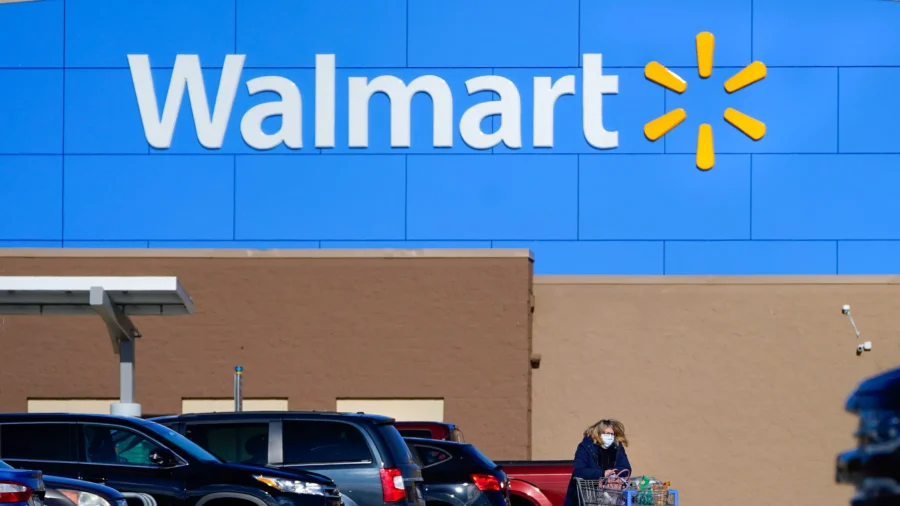Walmart reported strong revenue growth in the most recent quarter, with executives revealing that higher-income customers were behind a major portion of the company’s gains.
On May 16, Walmart announced its Q1, 2025, results for the three months ending March 31, reporting “strong revenue growth” of six percent, operating income growth of 9.6 percent, and ecommerce up by 21 percent globally. During the company’s earnings call on Thursday, CFO John David Rainey pointed out that while Walmart is seeing “higher engagement across income cohorts, with upper-income households continuing to account for the majority of the share gains.”
Walmart classifies customers into three income groups—$50,000 and below, $50,000 to $100,000, and $100,000 and above. As a general rule, “our customer base breaks down about a third in each group,” he said. Walmart is becoming more attractive to higher-income households by focusing on “convenience.”
“We are not just a play for value anymore. We talked about the number of units that we’ve shipped in the last 12 months, which is on par with any e-commerce player in the world. That shows that customers are coming to us and we’re a consideration where we haven’t been before,” Mr. Rainey said.
“And convenience matters to someone irrespective of what your paycheck is, irrespective of what your income level is, and we expect that to be durable. We don’t expect that to change.”
Walmart’s assertion that they were seeing stronger growth among higher-income customers comes as elevated inflation continues to trouble Americans.
Under the Trump administration, 12-month inflation had remained below 3 percent. After President Biden came to power, annual inflation jumped from 1.4 percent in January 2021 to 9.1 percent in June 2022.
Even though inflation came down over the following year, it has been stubbornly hovering above 3 percent since June 2023 and hasn’t broken below the level.
Providing Value
Walmart US CEO John Furner confirmed that the company has seen more growth on the high-end consumer front. The retail chain is focusing on “value, flexibility, and convenience,” which is currently working with customers across income segments, he said.
In the delivery business, “a lot of growth” was seen with the higher-income consumer base. “Seventy percent of the items under $5 is exciting. And that appeals to all income groups.”
Doug McMillon, Walmart CEO, said the company was not trying to chase higher-income customers. It is that “we just offer value.”
Historically, people with higher incomes have shopped at the company’s stores, he noted. Such groups have usually been selective in the categories they buy.
“So, if we offer them the right items at the right prices, whether that’s in store, first party, or marketplace, they’ll respond to that. And so, as we’ve been able to expand our assortment online, we can appeal to more people.”
According to a May 2 Gallup poll, Americans named inflation as the top financial problem they were facing. “The 41 percent naming the issue this year is up slightly from 35 percent a year ago and 32 percent in 2022. Before 2022, the highest percentage mentioning inflation was 18 percent in 2008,” Gallup said.
“Inflation has been named by less than 10 percent in most other readings since the question was first asked in 2005.” Elevated prices were cited as the top issue by upper and middle-income groups.
In the survey, 41 percent of upper-income ($100,000+) and 46 percent of middle-income ($40,000 to $99,999) groups said inflation was the number one problem. Among lower-income groups (less than $40,000), only 31 percent said inflation was the top issue they faced.
Inflation Impact on Elections
Inflation is a key issue in the upcoming presidential elections. April annual inflation was 3.4 percent. In a May 15 statement commenting on the data, President Biden said that “fighting inflation and lowering costs is my top economic priority.”
“I know many families are struggling, and that even though we’ve made progress we have a lot more to do. Inflation has fallen more than 60 percent from its peak, and core inflation fell to its lowest level in three years,” he said.
“Prices are still too high—so my agenda will give families breathing room by building two million new homes to lower housing costs, taking on Big Pharma to lower prescription drug prices, and calling on grocery chains making record profits to lower grocery prices for consumers.”
The president accused Congressional Republicans of wanting to increase costs rather than solve inflation by resorting to their “old trickle-down economics.”
He claimed Republicans want to slash taxes for big corporations and the ultra-wealthy while raising taxes for middle-class families. The GOP would protect Big Pharma and special interests while undermining workers and seniors by reducing social security and Medicare, the president claimed.
“All that would send inflation skyrocketing. I have a different vision for the future: one in which we take on special interests to lower costs and give the middle class a fair shot.”
While speaking to reporters earlier this month, former President Donald Trump blamed the surging inflation under the Biden administration on “his energy policies, his stupid green new deal of energy policies.”
In a May 17 press release, Senator Rick Scott (R-Fla.) said that consumer inflation has surged 19.9 percent since President Biden took office.
“With Biden at the helm, Democrats have made it clear that they want more government, more spending, more debt, higher taxes and they don’t care one bit if that means less freedom and opportunity for you,” he said.
According to a May 5 Ipsos poll, the economy (88 percent) and inflation (85 percent) were cited as the most important issues among Americans when determining who they will support in the presidential elections.
“More Americans trust Trump to handle the economy and inflation over Biden. Forty-six percent trust Trump and 32 percent trust Biden on the economy; meanwhile, 44 percent trust Trump and 30 percent trust Biden on inflation.”
From The Epoch Times

